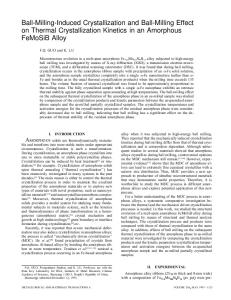Ball milling promoted direct liquefaction of lignocellulosic biomass in supercritical ethanol
- PDF / 768,558 Bytes
- 9 Pages / 595.276 x 785.197 pts Page_size
- 78 Downloads / 238 Views
RESEARCH ARTICLE
Ball milling promoted direct liquefaction of lignocellulosic biomass in supercritical ethanol Chunyan Yang1,2, Xiaoliang Yuan1, Xueting Wang1, Kejing Wu (✉)2, Yingying Liu2, Changjun Liu1, Houfang Lu1,2, Bin Liang1,2 1 School of Chemical Engineering, Sichuan University, Chengdu 610065, China 2 Institute of New Energy and Low-Carbon Technology, Sichuan University, Chengdu 610207, China
© Higher Education Press and Springer-Verlag GmbH Germany, part of Springer Nature 2019
Abstract In the present work, ball milling was applied for the pretreatment of lignocellulose to obtain high conversion and bio-oil yield in supercritical ethanol. Ball milling substantially decreased the crystallinity and particle size of lignocellulose, thereby improving its accessibility in ethanol solvent. An increased bio-oil yield of 59.2% was obtained for the ball milled camphorwood sawdust at 300°C, compared with 39.6% for the original lignocellulose. Decreased crystallinity significantly benefited the conversion of the cellulose component from 60.8% to 91.7%, and decreased particle size was beneficial for the conversion of all components. The obtained bio-oil had a high phenolic content, as analyzed by gas chromatography-mass spectrometry. Methoxylation and retro-aldol condensation were observed during alcoholysis, and the reaction pathways of lignocellulose in supercritical ethanol were attributed to the action of free radicals. Keywords ball milling, lignocellulose, supercritical ethanol, liquefaction, bio-oil
1
Introduction
Lignocellulose is an important, abundant, renewable resource for the production of chemicals and biofuels as an alternative to fossil fuels [1,2]. Many conversion methods are applied for the utilization of lignocellulose, such as thermochemical conversion, fermentation, and fractionation [3,4]. Thermochemical conversion can produce long carbon-chain chemicals and be applied to varied feedstock. Typical thermochemical methods include gasiReceived October 15, 2018; accepted March 8, 2019 E-mail: [email protected]
fication, pyrolysis, and liquefaction. Due to the mild reaction temperature [5], liquefaction with supercritical fluids is used to produce bio-oil from lignocellulose [6,7]. Ethanol has several advantages compared with water, including: reducing bio-oil acidity, preventing condensation and re-polymerization of the intermediates, and increasing heating value [8]. In addition, radicals in supercritical ethanol could benefit the macromolecular depolymerization of cellulose, hemicellulose and lignin, as well as redox reactions [9]. Despite high reactivity in supercritical ethanol, the complex structure of lignocellulose [10], containing crystal cellulose, amorphous hemicellulose, and three-dimensional lignin polymer, leads to difficulties in complete alcoholysis. To obtain a high bio-oil yield, heterogeneous/ homogeneous catalysts and/or hydrogen are commonly used [6,8,11]. However, the remaining feedstock and produced char are difficult to separate from the solid catalyst and easily results in catal
Data Loading...











